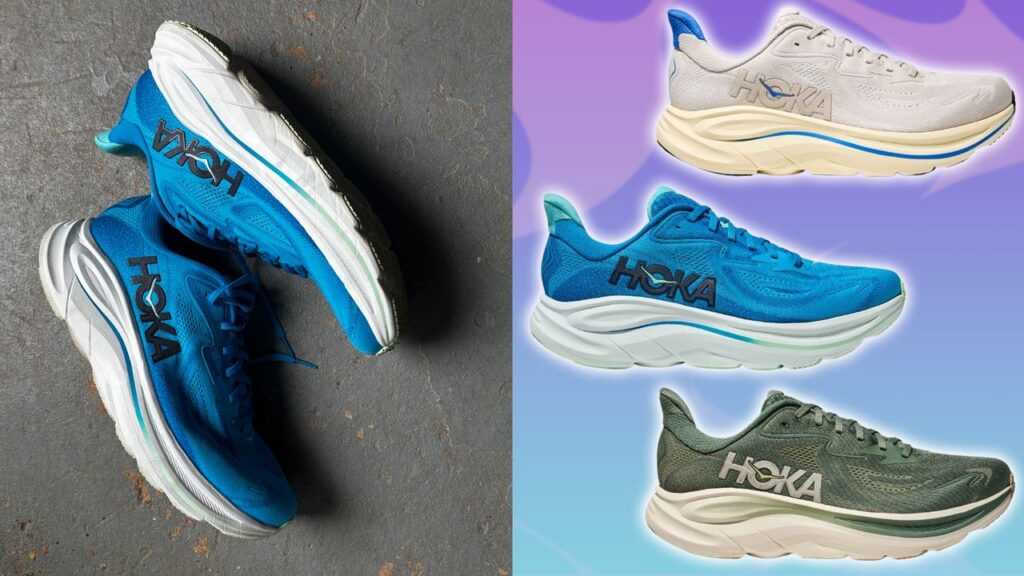If you’ve seen a pair of Hoka shoes in the wild, it’s probably the Clifton. And with the Hoka Clifton 10, the popular athletic brand has cinched its best-ever daily running shoe. While the running brand knows how to make footwear for every situation, it’s the Clifton that’s found the most success because of its versatility, comfort, and overall excellence. Not only does the flagship model support runners, but dozens of other active people from those working in hospitals to those strolling around a Saturday farmer’s market.
When it comes time to update a tried and true silhouette, there’s always a question of how much is too much or too little? The brand can’t push things too far as to get away from what works, but there needs to be some adjustments made to warrant the new model. So when the opportunity to test the Clifton 10 arrived, we were curious to see how Hoka was going to make their beloved trainer even better.
Over the course of the last few weeks and across a variety of different runs—long, short, and in-between—we tested the Hoka Clifton 10, putting it through its paces. How does it shape up? Dive into our thoughts below and see if the beloved classic is worth an upgrade to a new iteration.
In This Guide
Minor Design Upgrades You Won’t Notice on First Glance
The Clifton 10 looks similar to that of the Clifton 9, especially upon first glance. However, there’s a bit of a shift if you compare the two side-by-side. First of all, the toe box curves upward just a touch on the 10, combined with a bit of an adjustment in the midsole. Overall, however, the Clifton is more or less the same visually as what’s come before.
They’re also going to look a little bigger, thanks to an increased stack height and larger toe box, but with so many iterations of the shoe under its belt, Hoka hasn’t radically shifted the design, opting instead for just minor tweaks. It’s basically what you anticipate when upgrading your smartphone—it’s more or less the same, just better.
An Improved Toe Box Makes a Big Difference
One of the biggest complaints with previous versions of the Clifton is that of the toe box, with some runners feeling it was too narrow. Hoka’s adjusted that accordingly, which is going to make the shoe feel even more comfortable than it already did. As a result, the cushy bounce that the brand is known for gets even better. That’s an all-around win.
The biggest change is going to be that of the stack height, jumping up significantly to put it more in conversation with other popular daily trainers. That translates into having even more cushion as a result, allowing for a plush and cushy feel and fit.
The Same Cushioned Ride Hoka Is Known For
Those used to the feel of previous iterations won’t find radical shifts in the Clifton 10. In short, it still remains a deeply comfortable and cushioned shoe, one that’s extremely well-suited to all kinds of daily runs (granted, maybe leave these at home on speed days). I didn’t notice a huge impact on the stack height moving into this from other trainers, but those who move from the 9 to the 10 may feel differently.
These are still cushioned, with a touch of responsiveness to them. While there’s not as much as a spring compared to other running shoes—the Nike Pegasus Premium’s pop comes to mind, for example—there’s just a touch of return. That’s good to feel over a long run as the shoe fades into the background, providing silky smooth movement from toe to heel. Support, cushion, and sure-footedness are the name of the game with the Clifton, and the minor tweaks Hoka’s made throughout the construction of the 10 ensure that remains the case, providing a light and supremely cushioned ride.
Verdict: Is the Hoka Clifton 10 Worth It?
For a wide majority of casual runners, the Clifton 10s are still going to be a veritable one-stop shop for those looking to have a truly comfortable and easy run. The 10 isn’t flashy or overly tech-forward, but it doesn’t need to be. They’re a tried and true favorite that’s intended to put comfort at the forefront of every run, whether that’s a casual 5K with a run club or a long run trainer for those doing marathon prep. Plus, at $150, they’re right in the sweet spot of most daily trainers.
If it’s not broken, don’t fix it. While that might make for an update that comes across as safe from the outside looking in, the Clifton 10 continues to prove why so many people reach for Hoka’s comfort time and time again. The 10 continues that iterative process, ensuring one of the best daily trainers around remains deeply competitive and compelling in a field of tough challengers.


